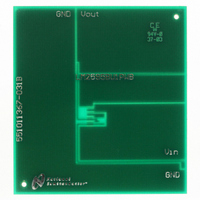551011367-031 National Semiconductor, 551011367-031 Datasheet - Page 22

551011367-031
Manufacturer Part Number
551011367-031
Description
BOARD WEBENCH BUILD IT LM2595
Manufacturer
National Semiconductor
Series
WEBENCH® Buildit Boardr
Datasheet
1.LM2595T-5.0NOPB.pdf
(29 pages)
Specifications of 551011367-031
Main Purpose
DC/DC, Step Down
Regulator Topology
Buck
Board Type
Bare (Unpopulated)
Utilized Ic / Part
LM2595
Lead Free Status / RoHS Status
Not applicable / Not applicable
Current - Output
-
Voltage - Output
-
Voltage - Input
-
Power - Output
-
Frequency - Switching
-
Outputs And Type
-
Other names
*551011367-031
www.national.com
Application Information
but with copper areas greater than approximately 3 in
small improvements in heat dissipation are realized. If fur-
ther thermal improvements are needed, double sided or mul-
tilayer PC-board with large copper areas are recommended.
The curves shown in Figure 20 show the LM2595S (TO-263
package) junction temperature rise above ambient tempera-
ture with a 1A load for various input and output voltages. This
data was taken with the circuit operating as a buck switching
regulator with all components mounted on a PC board to
simulate the junction temperature under actual operating
conditions. This curve can be used for a quick check for the
approximate junction temperature for various conditions, but
be aware that there are many factors that can affect the junc-
tion temperature.
For the best thermal performance, wide copper traces and
generous amounts of printed circuit board copper should be
used in the board layout. (One exception to this is the output
(switch) pin, which should not have large areas of copper.)
Large areas of copper provide the best transfer of heat
(lower thermal resistance) to the surrounding air, and moving
air lowers the thermal resistance even further.
Package thermal resistance and junction temperature rise
numbers are all approximate, and there are many factors
that will affect these numbers. Some of these factors include
board size, shape, thickness, position, location, and even
board temperature. Other factors are, trace width, total
printed circuit copper area, copper thickness, single- or
double-sided, multilayer board and the amount of solder on
the board. The effectiveness of the PC board to dissipate
heat also depends on the size, quantity and spacing of other
components on the board, as well as whether the surround-
ing air is still or moving. Furthermore, some of these compo-
nents such as the catch diode will add heat to the PC board
and the heat can vary as the input voltage changes. For the
inductor, depending on the physical size, type of core mate-
rial and the DC resistance, it could either act as a heat sink
taking heat away from the board, or it could add heat to the
board.
(Continued)
2
, only
22
Capacitors
Inductor
Diode
PC board
Capacitors
Inductor
Diode
PC board
FIGURE 19. Junction Temperature Rise, TO-220
FIGURE 20. Junction Temperature Rise, TO-263
Circuit Data for Temperature Rise Curve
Circuit Data for Temperature Rise Curve
Through hole electrolytic
Through hole, Schott, 68 µH
Through hole, 3A 40V, Schottky
3 square inches single sided 2 oz. copper
(0.0028")
Surface mount tantalum, molded “D” size
Surface mount, Schott, 68 µH
Surface mount, 3A 40V, Schottky
3 square inches single sided 2 oz. copper
(0.0028")
TO-263 Package (S)
TO-220 Package (T)
DS012565-34
DS012565-35










